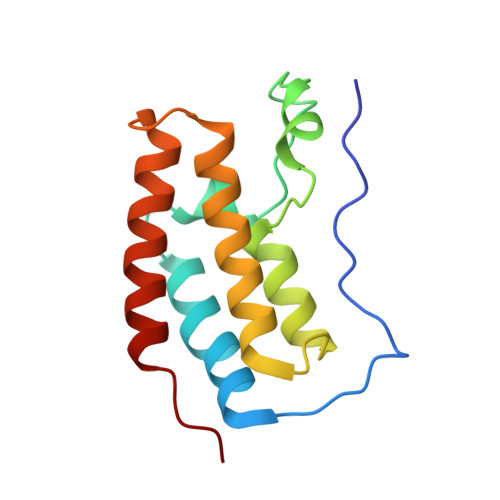Discovery and Preclinical Pharmacology of an Oral Bromodomain and Extra-Terminal (BET) Inhibitor Using Scaffold-Hopping and Structure-Guided Drug Design.
Gavai, A.V., Norris, D., Delucca, G., Tortolani, D., Tokarski, J.S., Dodd, D., O'Malley, D., Zhao, Y., Quesnelle, C., Gill, P., Vaccaro, W., Huynh, T., Ahuja, V., Han, W.C., Mussari, C., Harikrishnan, L., Kamau, M., Poss, M., Sheriff, S., Yan, C., Marsilio, F., Menard, K., Wen, M.L., Rampulla, R., Wu, D.R., Li, J., Zhang, H., Li, P., Sun, D., Yip, H., Traeger, S.C., Zhang, Y., Mathur, A., Zhang, H., Huang, C., Yang, Z., Ranasinghe, A., Everlof, G., Raghavan, N., Tye, C.K., Wee, S., Hunt, J.T., Vite, G., Westhouse, R., Lee, F.Y.(2021) J Med Chem 64: 14247-14265
- PubMed: 34543572
- DOI: https://doi.org/10.1021/acs.jmedchem.1c00625
- Primary Citation of Related Structures:
5S9O, 5S9P, 5S9Q, 5S9R - PubMed Abstract:
Inhibition of the bromodomain and extra-terminal (BET) family of adaptor proteins is an attractive strategy for targeting transcriptional regulation of key oncogenes, such as c-MYC. Starting with the screening hit 1 , a combination of structure-activity relationship and protein structure-guided drug design led to the discovery of a differently oriented carbazole 9 with favorable binding to the tryptophan, proline, and phenylalanine (WPF) shelf conserved in the BET family. Identification of an additional lipophilic pocket and functional group optimization to optimize pharmacokinetic (PK) properties culminated in the discovery of 18 (BMS-986158) with excellent potency in binding and functional assays. On the basis of its favorable PK profile and robust in vivo activity in a panel of hematologic and solid tumor models, BMS-986158 was selected as a candidate for clinical evaluation.
Organizational Affiliation:
Research and Development, Bristol Myers Squibb Company, P. O. Box 4000, Princeton, New Jersey 08543-4000, United States.
















